CHART CryoDoser FleX User manual

Part Number 15960 Rev. A
© 2017 Chart Inc.
Designed and Built by:
Chart Inc.
46441 Landing Parkway
Fremont, CA 94538 USA
(800) 371-3303
Product Manual
CryoDoser FleX™
Liquid Nitrogen Dosing System


iii
Product Manual - CryoDoser FleX™LN2Dosing System
Contents
Revision Log . . . . . . . . . . . . . . . . . . . . . . . . . . . . . . . . . . . . . . . . . . . . . . iv
Preface . . . . . . . . . . . . . . . . . . . . . . . . . . . . . . . . . . . . . . . . . . . . . . . . . . . . .1
General . . . . . . . . . . . . . . . . . . . . . . . . . . . . . . . . . . . . . . . . . . . . . . . . . .1
Features . . . . . . . . . . . . . . . . . . . . . . . . . . . . . . . . . . . . . . . . . . . . . . . . . .1
Key Benets . . . . . . . . . . . . . . . . . . . . . . . . . . . . . . . . . . . . . . . . . . . . . . . .1
Product Manual . . . . . . . . . . . . . . . . . . . . . . . . . . . . . . . . . . . . . . . . . . . . . .1
Terms . . . . . . . . . . . . . . . . . . . . . . . . . . . . . . . . . . . . . . . . . . . . . . . . . . .2
Acronyms / Abbreviations. . . . . . . . . . . . . . . . . . . . . . . . . . . . . . . . . . . . . . . . .2
Safety . . . . . . . . . . . . . . . . . . . . . . . . . . . . . . . . . . . . . . . . . . . . . . . . . . . . .3
General . . . . . . . . . . . . . . . . . . . . . . . . . . . . . . . . . . . . . . . . . . . . . . . . . .3
Safety Bulletin. . . . . . . . . . . . . . . . . . . . . . . . . . . . . . . . . . . . . . . . . . . . . . .4
Oxygen Decient Atmospheres . . . . . . . . . . . . . . . . . . . . . . . . . . . . . . . . . . . . . .4
Nitrogen . . . . . . . . . . . . . . . . . . . . . . . . . . . . . . . . . . . . . . . . . . . . . . . . . .4
Installation. . . . . . . . . . . . . . . . . . . . . . . . . . . . . . . . . . . . . . . . . . . . . . . . . . .5
Receiving . . . . . . . . . . . . . . . . . . . . . . . . . . . . . . . . . . . . . . . . . . . . . . . . .5
Unpacking . . . . . . . . . . . . . . . . . . . . . . . . . . . . . . . . . . . . . . . . . . . . . . . . .5
Installation. . . . . . . . . . . . . . . . . . . . . . . . . . . . . . . . . . . . . . . . . . . . . . . . .5
Application Evaluation . . . . . . . . . . . . . . . . . . . . . . . . . . . . . . . . . . . . . . . .5
Support Stand and Base Location . . . . . . . . . . . . . . . . . . . . . . . . . . . . . . . . . .5
Mounting the Dosing Body. . . . . . . . . . . . . . . . . . . . . . . . . . . . . . . . . . . . . .6
Mounting the Control and Interface Boxes. . . . . . . . . . . . . . . . . . . . . . . . . . . . . .6
Top Tube Connections . . . . . . . . . . . . . . . . . . . . . . . . . . . . . . . . . . . . . . . .6
Electro-Mechanical Connections . . . . . . . . . . . . . . . . . . . . . . . . . . . . . . . . . . .7
Installing the Nozzle . . . . . . . . . . . . . . . . . . . . . . . . . . . . . . . . . . . . . . . . .7
Positioning the Dosing Head . . . . . . . . . . . . . . . . . . . . . . . . . . . . . . . . . . . . .9
Installing the Container Detect Sensor . . . . . . . . . . . . . . . . . . . . . . . . . . . . . . . .9
Installing the Timing Sensor . . . . . . . . . . . . . . . . . . . . . . . . . . . . . . . . . . . . .9
Installing the Encoder . . . . . . . . . . . . . . . . . . . . . . . . . . . . . . . . . . . . . . . 10
Installing the FleX Controller . . . . . . . . . . . . . . . . . . . . . . . . . . . . . . . . . . . 11
Completed Assembly . . . . . . . . . . . . . . . . . . . . . . . . . . . . . . . . . . . . . . . . . . 11
Daily Operating Procedures . . . . . . . . . . . . . . . . . . . . . . . . . . . . . . . . . . . . . . . . 13
Dura-Cyl® Liquid Cylinder Fed System. . . . . . . . . . . . . . . . . . . . . . . . . . . . . . . . .13
Dura-Cyl Cylinder Change Out Procedure . . . . . . . . . . . . . . . . . . . . . . . . . . . . .13
Bulk Tank (House Fed) System . . . . . . . . . . . . . . . . . . . . . . . . . . . . . . . . . . . . . 14
Purging with Gaseous Nitrogen . . . . . . . . . . . . . . . . . . . . . . . . . . . . . . . . . . 14
System Start Up. . . . . . . . . . . . . . . . . . . . . . . . . . . . . . . . . . . . . . . . . . .14
System Shut Down . . . . . . . . . . . . . . . . . . . . . . . . . . . . . . . . . . . . . . . . . 15
Best Practices for Superb Operation . . . . . . . . . . . . . . . . . . . . . . . . . . . . . . . . . . 15
Minimize the entry of moisture into the dosing system . . . . . . . . . . . . . . . . . . . . . . 15
Nozzle use . . . . . . . . . . . . . . . . . . . . . . . . . . . . . . . . . . . . . . . . . . . . . 15
Sensors . . . . . . . . . . . . . . . . . . . . . . . . . . . . . . . . . . . . . . . . . . . . . . . 15
How much LN2is needed? . . . . . . . . . . . . . . . . . . . . . . . . . . . . . . . . . . . . .16
Service and Maintenance . . . . . . . . . . . . . . . . . . . . . . . . . . . . . . . . . . . . . . . . . .17
Activating Insta-Purge. . . . . . . . . . . . . . . . . . . . . . . . . . . . . . . . . . . . . . . . . .17
Nozzle Change Out . . . . . . . . . . . . . . . . . . . . . . . . . . . . . . . . . . . . . . . . . . . 17
Nozzle Cleaning . . . . . . . . . . . . . . . . . . . . . . . . . . . . . . . . . . . . . . . . . . . . .17
Purging with Gaseous Nitrogen . . . . . . . . . . . . . . . . . . . . . . . . . . . . . . . . . . . . .18
Troubleshooting . . . . . . . . . . . . . . . . . . . . . . . . . . . . . . . . . . . . . . . . . . . . . 18

iv
Table of Contents Product Manual - CryoDoser FleX™LN2Dosing System
Revision Log
Revision Level Date Description
A 08/30/2017 Original
Specications . . . . . . . . . . . . . . . . . . . . . . . . . . . . . . . . . . . . . . . . . . . . . . . . 19
CryoDoser FleX Technical Specications. . . . . . . . . . . . . . . . . . . . . . . . . . . . . . . .19
CryoDoser FleX Components . . . . . . . . . . . . . . . . . . . . . . . . . . . . . . . . . . . . . .20
Standard Components . . . . . . . . . . . . . . . . . . . . . . . . . . . . . . . . . . . . . . . 20
Optional Components. . . . . . . . . . . . . . . . . . . . . . . . . . . . . . . . . . . . . . . .20
Common Replacement Parts . . . . . . . . . . . . . . . . . . . . . . . . . . . . . . . . . . . . . . 21
Sensor Positioning. . . . . . . . . . . . . . . . . . . . . . . . . . . . . . . . . . . . . . . . . . . .22
Craft Custom Control Box Schematic. . . . . . . . . . . . . . . . . . . . . . . . . . . . . . . . . .23
Craft Custom Interface Box Schematic . . . . . . . . . . . . . . . . . . . . . . . . . . . . . . . . . 24
Warranty . . . . . . . . . . . . . . . . . . . . . . . . . . . . . . . . . . . . . . . . . . . . . . . . . . 25

1
Product Manual - CryoDoser FleX™LN2Dosing System
General
The CryoDoser FleX™LN2 Dosing System is the rst doser
with the ability to serve every dosing application within one
unit. Chart Inc. has designed a brand new dosing system that
can be used from the slowest production lines to the fastest.
The CryoDoser FleX line features two distinct controller
systems but keeps the look and feel of each very similar. The
Craft Custom system includes the capability of changing
dose duration and dose delays for up to ten containers. The
Pack Premier system is capable of speeds in excess of 2000
cpm with superb accuracy.
With two premium controller options, more standard
functions than any other doser offered before, and a brand
new all-around design, the CryoDoser FleX system is ready
to change the market.
Features
• Compact Size - enables installation in limited spaces
• Discrete Dosing - Craft Custom (750 cpm) and Pack
Premier (2000+ cpm)
• SoftDose™ Compatible - Chart’s proven technology for
hot ll, powder and granular applications.
• MicroDose™ Standard - the Pack Premier has a controller
function that allows dosing pressure adjustments
• RemoteDose™ Standard* - monitor, troubleshoot and
make adjustments while connected to your VPN**
• ExacTrack™ - with the new EDS (Electric Dosing
System), supreme accuracy is achieved. Proportionally
control the amount the actuator opens and make dosing
duration changes in increments of 0.1 ms.
• Warranty - four (4) year vacuum warranty; highest in the
industry; one (1) year controller warranty
*Results achieved at Chart laboratory conditions.
**Access to the internal network is necessary for this function.
Key Benets
• Lightweight PET - reduce the weight of PET for cost and
environmental savings
• Glass to PET Transition - eliminate glass safety hazards
and weight of containers
• Container Rigidity - maintain container shape even with
lighter weight containers
• Eliminate Paneling - increase the internal pressure to
offset paneling issues
• Oxygen Reduction - create an inert environment to
preserve product freshness
• Extend Shelf Life - minimize oxygen levels
• Ease of Labeling - consistent container rigidity creates an
efcient labeling process
• Reduce Nitrogen Consumption - measurable and
repeatable liquid doses
• Maximize Warehouse Storage Space - increasing product
stackability utilizes less square footage
• Stabilize Organic Products - extend shelf life without
preservatives
Product Manual
This manual is designed to be used in conjunction with the
CryoDoser FleX Liquid Nitrogen Dosing System provided
by Chart. Chart makes no warranties, express or implied,
regarding the content in this manual. Chart assumes no
responsibility for any outcomes as a result of using this
manual. If after reading this manual you are not condent in
carrying out any task, please contact Chart’s service team at
1-408-371-4932.
The safety requirements for operating the CryoDoser FleX
system and handling or transporting extremely cold liquid
products are shown in the Safety section. Use this safety
section as a “Safety Checklist” each time the equipment is
being used.
In the Installation section there are illustrations for proper
connections.
The Controller Adjustments and Daily Operations Section
will give information on getting the system up and running
smoothly.
The remaining sections provide information on Service,
Troubleshooting, Specications and the Warranty provided
by Chart.
Preface
Table of contents
Other CHART Industrial Equipment manuals
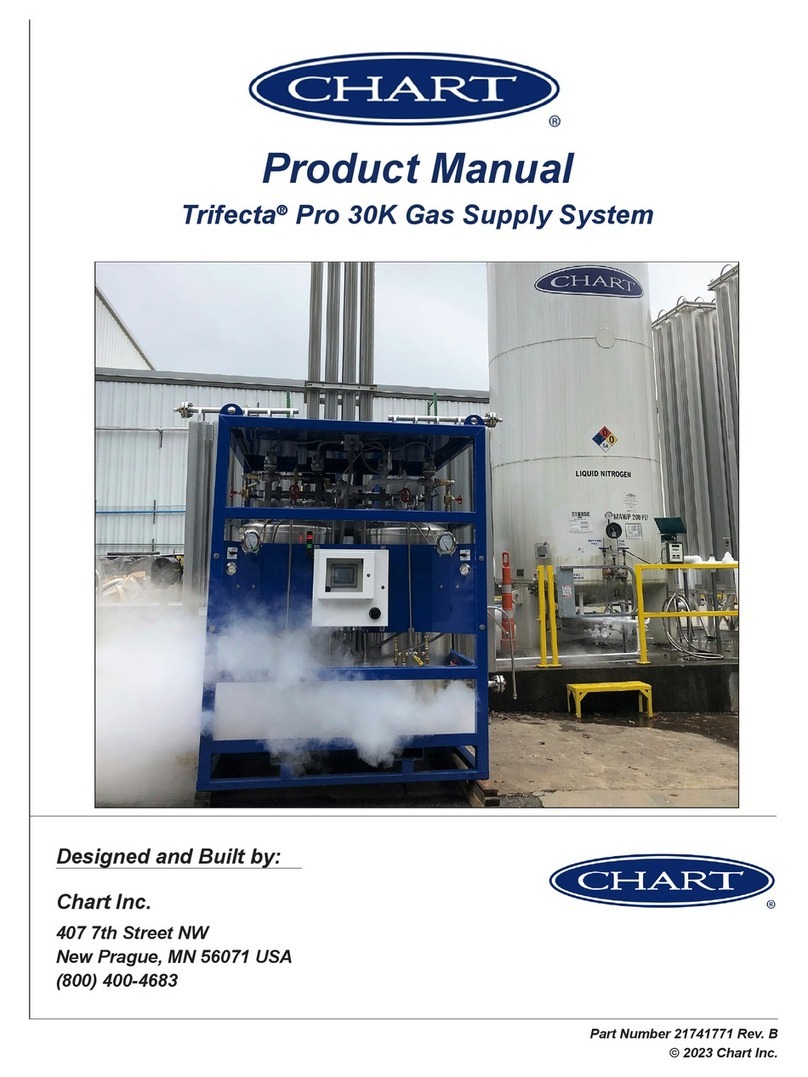
CHART
CHART Trifecta Pro 30K User manual
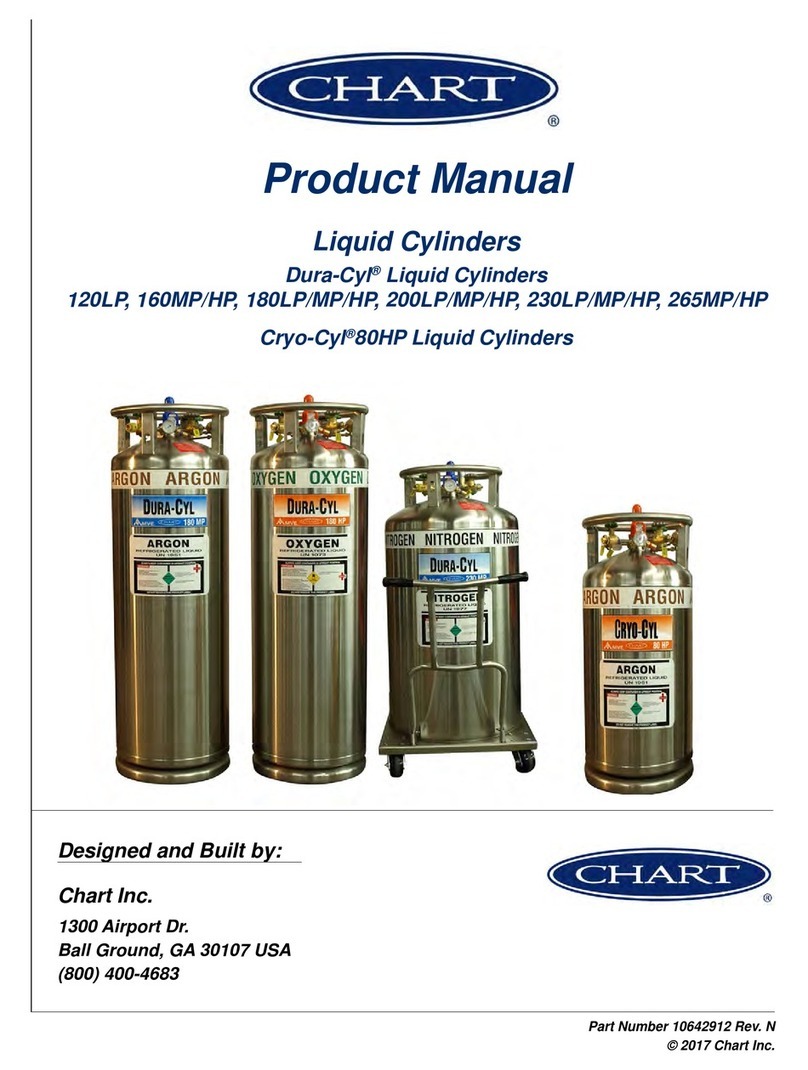
CHART
CHART Dura-Cyl 120LP User manual
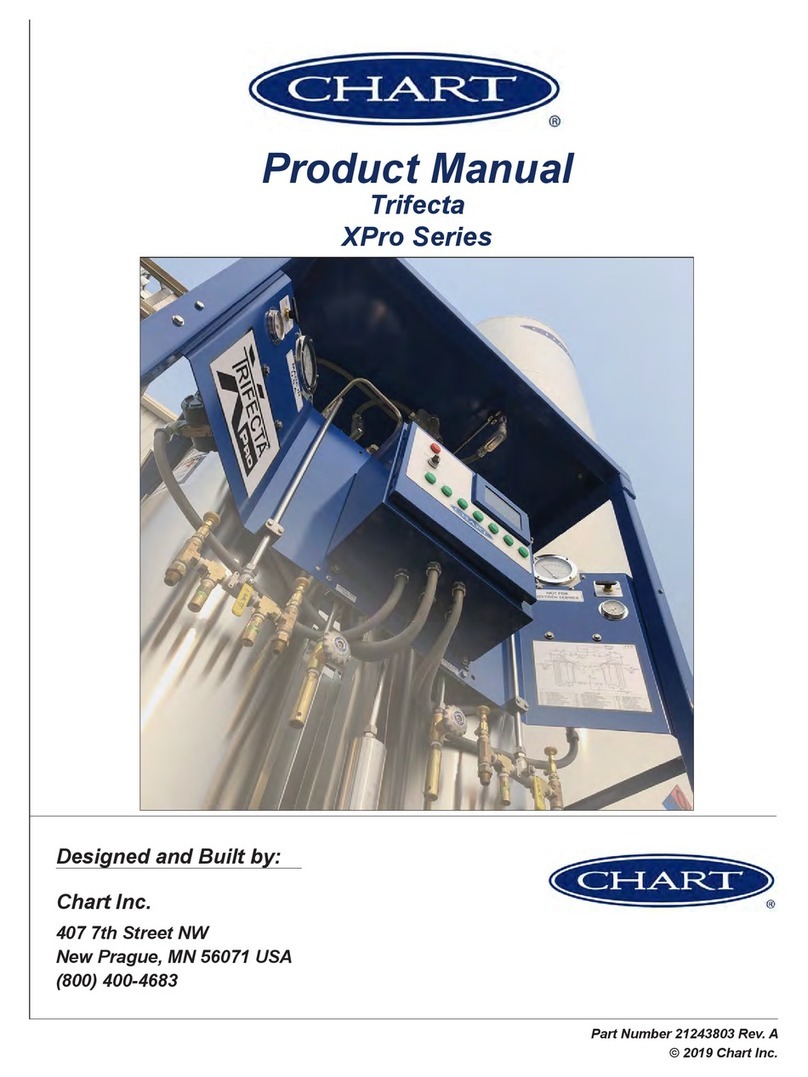
CHART
CHART Trifecta XPro Series User manual
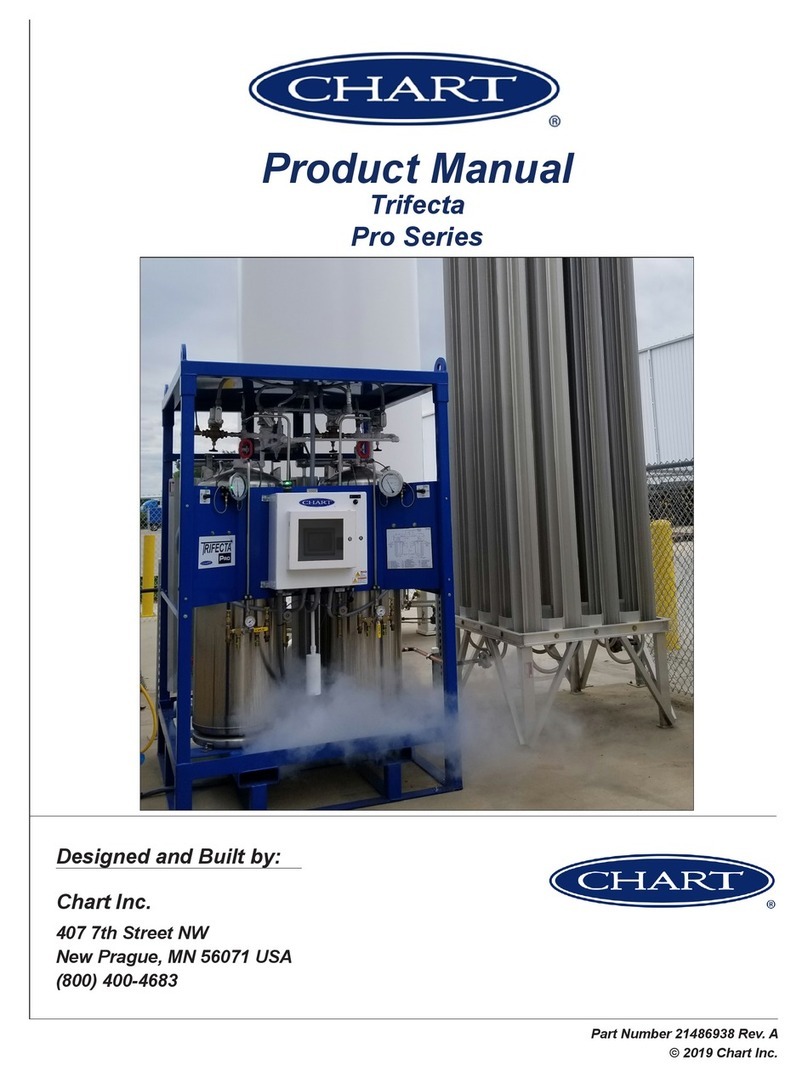
CHART
CHART Trifecta Pro Series User manual
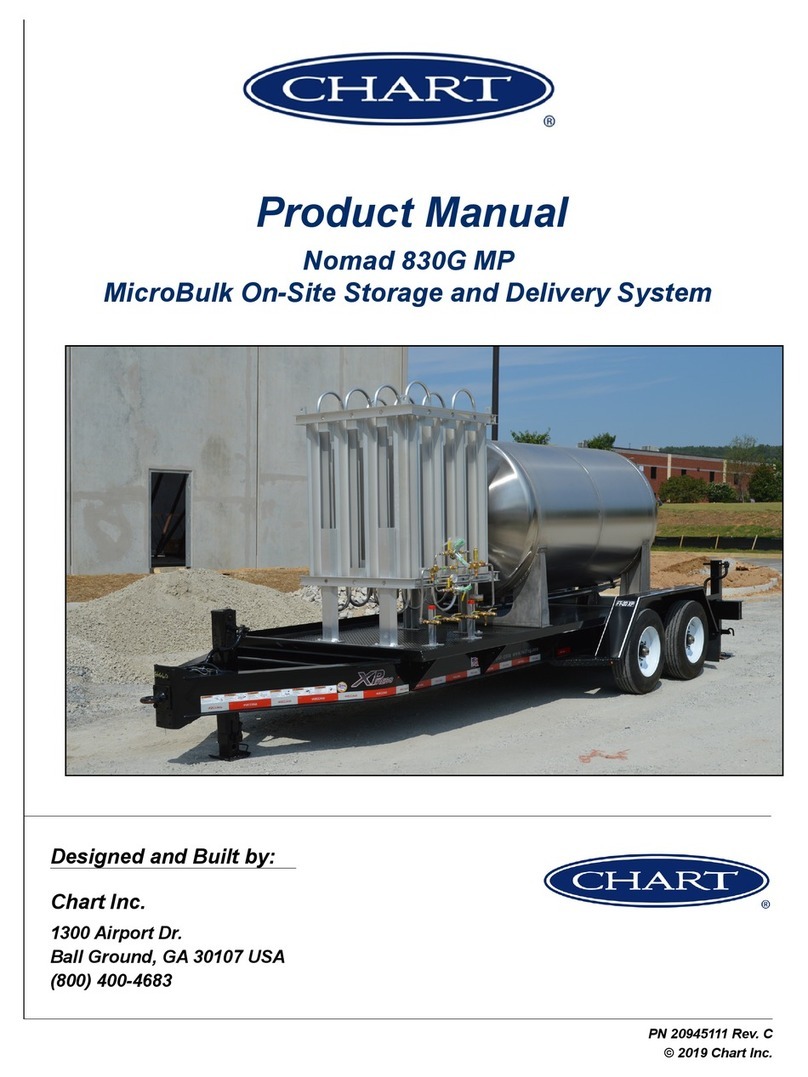
CHART
CHART Nomad 830G MP User manual
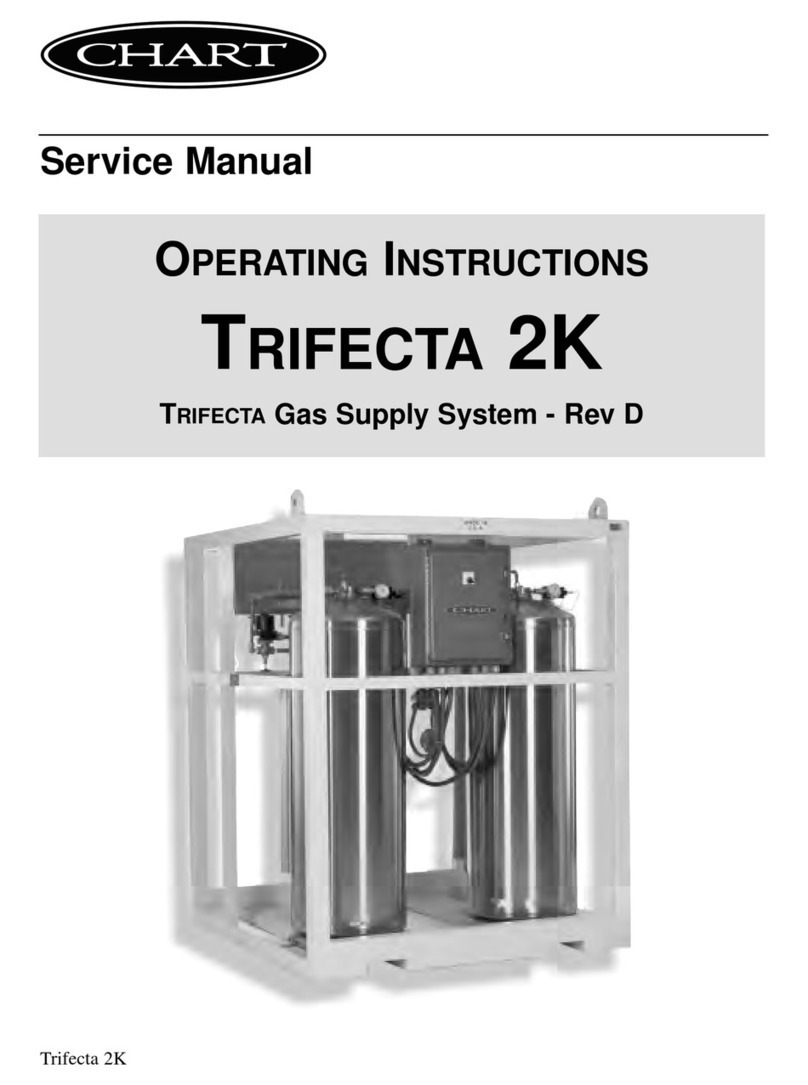
CHART
CHART TRIFECTA 2K User manual
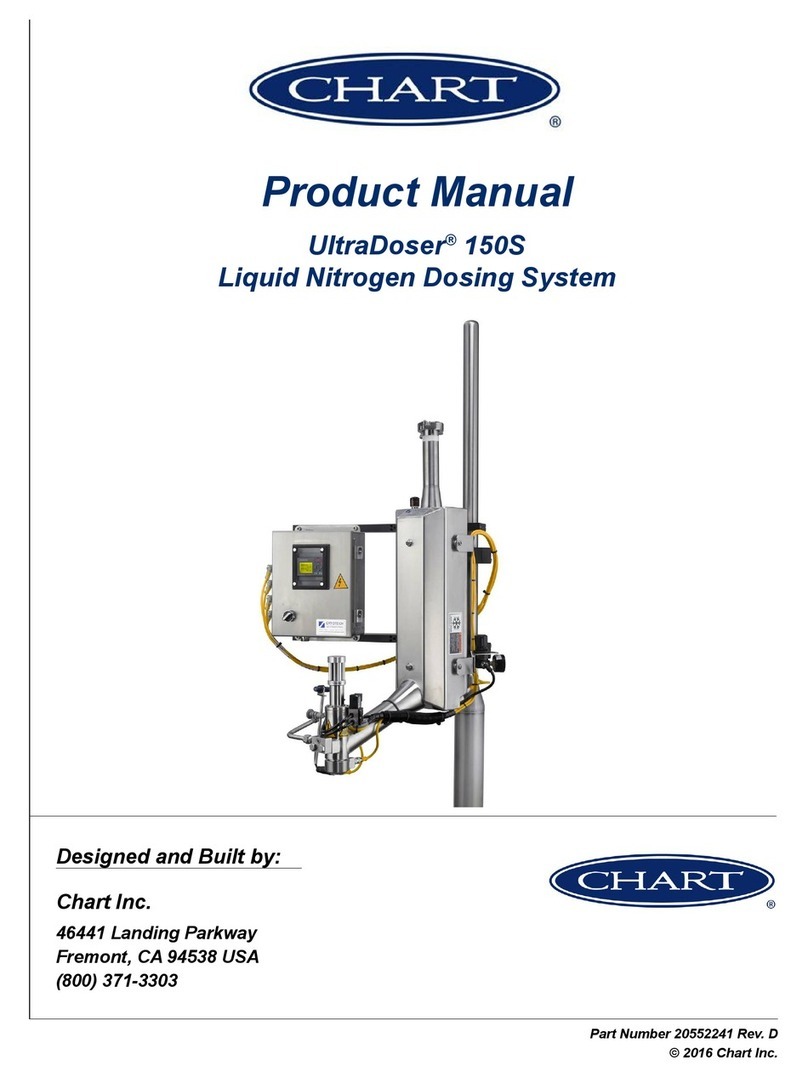
CHART
CHART UltraDoser 150S User manual

CHART
CHART ULTRADOSER 500S User manual
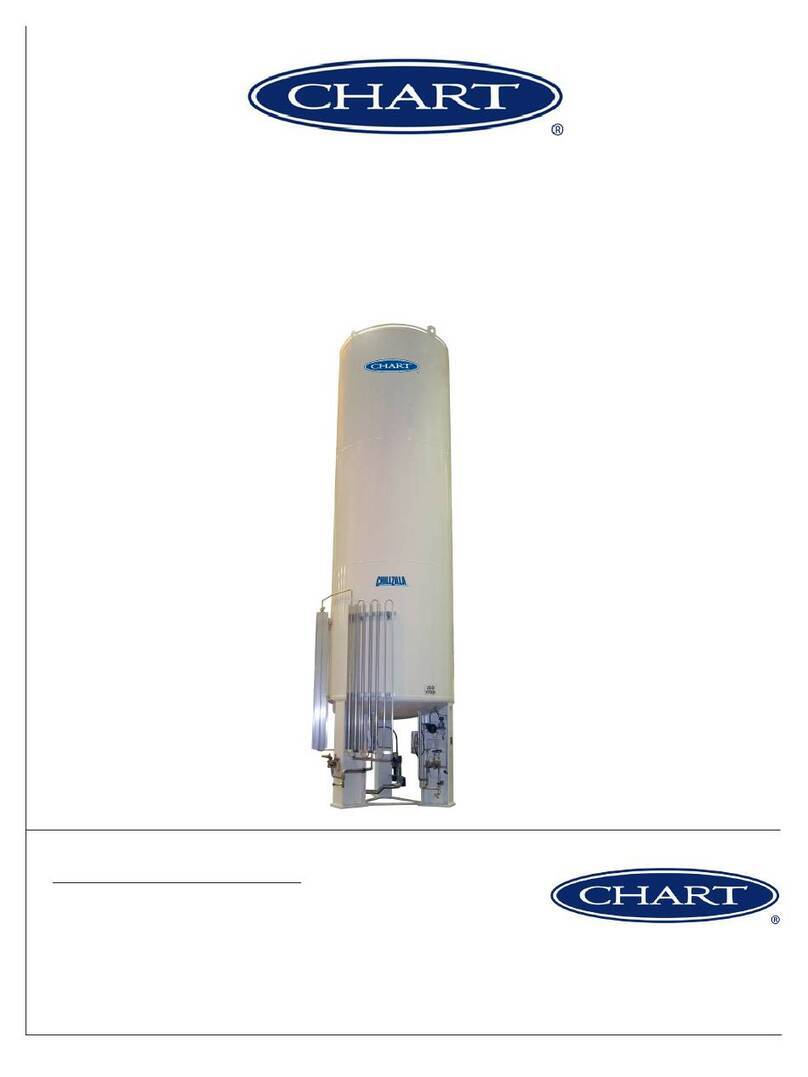
CHART
CHART ChillZilla VS-9000CZ User manual

















